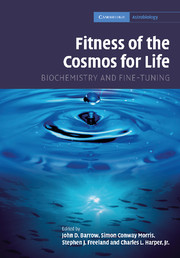Book contents
- Frontmatter
- Contents
- List of contributors
- Foreword: The improbability of life
- Preface
- Acknowledgments
- Part I The fitness of “fitness”: Henderson in context
- Part II The fitness of the cosmic environment
- 6 Fitness and the cosmic environment
- 7 The interconnections between cosmology and life
- 8 Chemistry and sensitivity
- 9 Fitness of the cosmos for the origin and evolution of life: from biochemical fine-tuning to the Anthropic Principle
- Part III The fitness of the terrestrial environment
- Part IV The fitness of the chemical environment
- Index
- References
6 - Fitness and the cosmic environment
Published online by Cambridge University Press: 18 December 2009
- Frontmatter
- Contents
- List of contributors
- Foreword: The improbability of life
- Preface
- Acknowledgments
- Part I The fitness of “fitness”: Henderson in context
- Part II The fitness of the cosmic environment
- 6 Fitness and the cosmic environment
- 7 The interconnections between cosmology and life
- 8 Chemistry and sensitivity
- 9 Fitness of the cosmos for the origin and evolution of life: from biochemical fine-tuning to the Anthropic Principle
- Part III The fitness of the terrestrial environment
- Part IV The fitness of the chemical environment
- Index
- References
Summary
The problem of what exists: why this universe?
Einstein reportedly said: “What really interests me is whether God had any choice in the creation of the world”. What he meant by this informal remark was whether the physical universe must necessarily exist as it is or whether it could have been otherwise (or could have not existed at all). Today, almost all scientists believe that the universe could indeed have been otherwise; no logical reason exists why it has to be as it is. In fact, it is the job of the experimental scientist to determine which universe actually exists, from among the many universes that might possibly exist. And it is the job of the theoretician to construct alternative models of physical reality, perhaps to simplify or isolate a particular feature of interest. To be credible, these models must be mathematically and logically self-consistent. In other words, they represent possible worlds.
Let me give one example from my own research (Birrell and Davies, 1978). The equations of quantum field theory describing a system of interacting subatomic particles are often mathematically intractable. But several “toy models” exist, the equations for which may be solved exactly because of special mathematical features. One of these, known as the Thirring model, describes a two-spacetime-dimensional world inhabited by self-interacting fermions. This impoverished model of reality is designed to capture some features of interest to physicists in the real world. It is not, obviously, an attempt to describe the real world in its entirety.
- Type
- Chapter
- Information
- Fitness of the Cosmos for LifeBiochemistry and Fine-Tuning, pp. 97 - 113Publisher: Cambridge University PressPrint publication year: 2007
References
- 1
- Cited by



